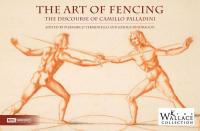Description
Until now, Camillo Palladini's manuscript for his discourse on fencing was housed in the De Walden Library at the Wallace Collection in London. Hitherto unpublished and largely unknown, it is of central importance to a modern understanding of Italian rapier play in the sixteenth century. This stunning book, a joint endeavour between the Royal Armouries and the Wallace Collection, reproduces the forty-six red chalk illustrations in the manuscript--only three of which have ever been seen in print--together with a transcription and translation of the original Italian text. Perfect for students of fencing, lovers of Italian art, sixteenth-century researchers, and historical reenactors and interpreters, The Art of Fencing: The Forgotten Discourse of Camillo Palladini showcases a striking example of Renaissance swordsmanship.
Last updated on
Product Details
- Royal Armouries Brand
- Jan 2, 2020 Pub Date:
- 9780948092961 ISBN-13:
- 0948092963 ISBN-10:
- 224 Pages
- English Language
- 8 in * 11.9 in * 1.2 in Dimensions:
- 3 lb Weight:




